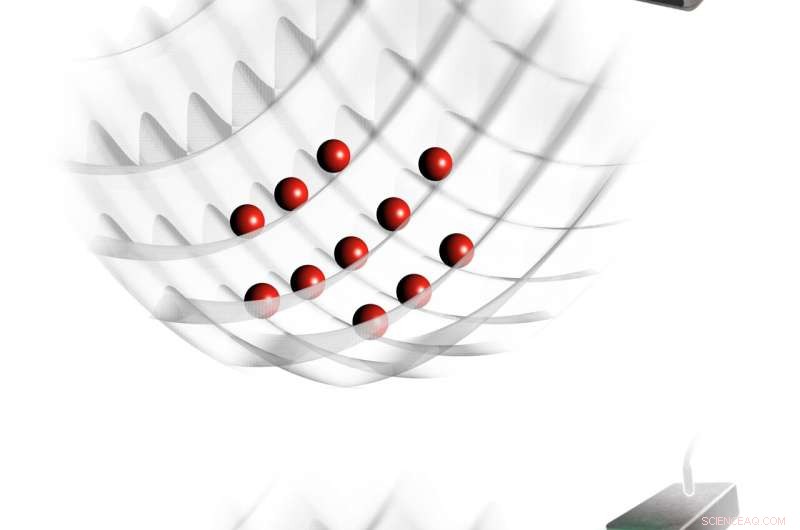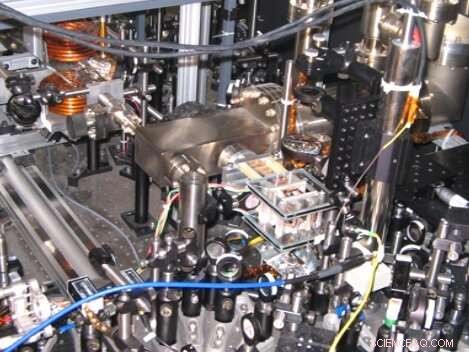
Un rendu artistique des résultats de la recherche dans l'étude des polaritons montre les atomes d'un réseau optique formant une phase isolante (à gauche) ; les atomes se transformant en polaritons d'onde de matière via un couplage sous vide médié par un rayonnement micro-onde représenté par la couleur verte (au centre) ; les polaritons deviennent mobiles et forment une phase superfluide pour un fort couplage du vide (à droite). Crédit :Alfonso Lanuza/Schneble Lab/Stony Brook University.
Les polaritons sont des quasi-particules qui se forment lorsque les photons se couplent fortement avec les excitations de la matière. Ces quasi-particules, qui sont mi-lumière et mi-matière, sous-tendent le fonctionnement d'un large éventail de systèmes quantiques photoniques émergents, y compris les dispositifs nanophotoniques à base de semi-conducteurs et les systèmes électrodynamiques quantiques à circuits.
Des chercheurs de l'Université de Stony Brook ont récemment introduit un nouveau système de polariton dans lequel l'excitation de la matière est remplacée par un atome dans un réseau optique et le photon par une onde de matière atomique. Ce système, présenté dans un article publié dans Nature Physics , aboutit à des polaritons d'ondes de matière, et pourrait ouvrir des possibilités intéressantes pour l'étude de la matière quantique polaritonique.
"Il y a quelques années, nous nous sommes intéressés à l'idée d'utiliser des atomes ultrafroids pour simuler le comportement dynamique des émetteurs quantiques", a déclaré le Dr Dominik Schneble, chef de l'équipe de chercheurs qui a mené l'étude, à Phys.org. "Il s'avère qu'il est possible de construire un atome artificiel qui émet spontanément des ondes de matière, à peu près de la même manière qu'un atome émet spontanément un photon (comme décrit par le modèle dit de Weisskopf-Wigner)."
Schneble et ses collègues ont montré que l'utilisation d'un tel atome artificiel au lieu d'un «vrai atome» pour étudier le comportement dynamique des émetteurs quantiques présentait quelques avantages. Plus particulièrement, le système artificiel a permis aux chercheurs de régler librement des paramètres importants, tels que l'énergie d'excitation de l'émetteur et son couplage au vide.
L'émetteur artificiel qu'ils ont initialement créé consistait en un piège microscopique (c'est-à-dire un puits du réseau optique), qui était rempli d'un seul atome. L'équipe a mis en place un mécanisme permettant à l'atome unique d'inverser son spin et d'être libéré spontanément dans un guide d'ondes de matière, dans lequel les pièges eux-mêmes étaient intégrés.
"Essentiellement et contrairement aux émetteurs quantiques conventionnels, c'était le seul mécanisme de désintégration autorisé et le rayonnement ne pouvait pas s'échapper ailleurs", a expliqué Schneble. "Dans un article paru dans Nature en 2018, nous avons observé que la décomposition dans ces conditions peut avoir des caractéristiques assez exotiques. En particulier, lorsque nous définissons l'énergie d'excitation comme étant négative (cela peut sembler bizarre, mais peut également être valable pour les "vrais émetteurs" dans un matériau à bande interdite photonique), le rayonnement d'onde de matière émis, ayant une énergie négative, ne pouvait pas s'échapper et à la place planait autour de l'émetteur sous la forme d'un nuage cohérent d'excitations du vide."

An artistic rendering of the research findings in the polariton study shows the atoms in an optical lattice forming an insulating phase (left); atoms turning into matter-wave polaritons via vacuum coupling mediated by microwave radiation represented by the green color (center); polaritons becoming mobile and forming a superfluid phase for strong vacuum coupling (right). Credit:Alfonso Lanuza/Schneble Lab/Stony Brook University.
In their new study, Schneble and his colleagues leveraged the fact that the emitters they had implemented (i.e., the wells) were indeed part of a periodic lattice that can also contain many atoms. As a result, transport and interaction effects inside the lattice can become important.
"If we for a moment neglect the emission features but just look at the lattice, these atoms can by themselves tunnel, or hop, from site to site," Schneble said. "Whether or not this happens depends on the strength of the hopping compared to the energy cost due to the repulsion between two or more atoms on the same lattice site (this is known as the Bose-Hubbard model)."
The key objective of the researchers' study was to determine what happens when they turned on the emission features on their optical lattice system, especially at a negative energy where radiation cannot escape. Interestingly, they found evidence that hovering matter waves tended to leak into neighboring wells.
In a neighboring well, an inverse decay (i.e., absorption) process can convert the hovering matter wave back into a trapped atom. Through this process, the originating well simultaneously empties out.
"This effectively means that the trapped atom, dressed in the matter-wave cloud, has an additional mechanism to hop between lattice sites," Schneble said. "On the other hand, the matter waves in the waveguide can never freely travel on their own and, being chained to the atoms in the lattice, all they can do is hop along."
As a result, in this system the matter waves become less mobile, or "heavier," while the atom becomes more mobile, or "lighter." The matter waves and the atoms in the lattice form composite quasiparticles that carry aspects of both its constituents, dubbed "matter-wave polaritons."

The ultracold-atom apparatus with which the matter-wave polariton experiments were performed. Credit:Schneble Lab/Stony Brook University.
"What makes this system interesting is that the atoms in the lattice (which one might themselves call 'excitations of the empty lattice') repel each other on the sites," Schneble explained. "Now, if matter waves are bound to those atoms, then there is also an effective repulsion between the matter waves. Translating this back to a conventional polariton system in which you replace our matter waves with photons and the hopping atoms in the lattice with exciton polaritons (or other matter excitations), now you have at your disposal an effective repulsion between photons."
On their own, photons are known not to interact with each other. The strong polariton interaction unveiled by the researchers is thus very interesting when extrapolated to a conventional system.
"The unique feature of our platform is that the matter-wave polaritons are loss-free, in contrast to photon-based polariton systems, whose lifetime is limited by spontaneous radiative decay into the environment," Schneble said.
Similarly to their earlier studies focusing on spontaneous decay, the recent polariton work by this team of researchers opens new possibilities for accessing parameter regimes that have so far been inaccessible using conventional photon-based systems. In the future, it could thus enable in-depth explorations of polariton physics in new regimes.
"Our research allows for studies of polaritonic systems with the high flexibility and control of an analog quantum simulation," Schneble added. "Because of the absence of uncontrolled radiative losses, it is generally quite interesting to explore strongly coupled radiative systems with matter waves, and polariton features will play an important role in such studies. Of course, polaritonic platforms themselves have high relevance for applications in QIST, and our work should be of interest in this context as well."
© 2022 Réseau Science X Discovery of matter-wave polaritons sheds new light on photonic quantum technologies